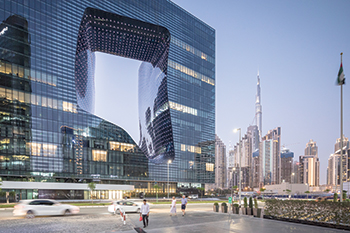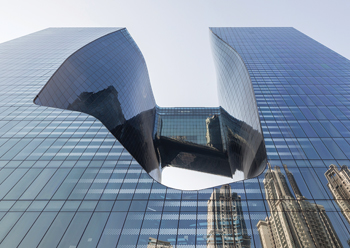Bold and beautiful
The Opus building in Dubai, designed by the late Zaha Hadid, catches the eye on account of its bold architecture which explores the balance between solid and void, opaque and transparent, interior and exterior.
01 June 2020
The newly opened Opus building in Dubai’s Burj Khalifa district, adjacent to Downtown Dubai and Business Bay on the Dubai Water Canal, has certainly been turning a few glances away from the world’s tallest tower – Burj Khalifa – on account of its bold architecture.
Designed by the late Zaha Hadid in 2007, the striking building is home to the new ME Dubai which stakes claim to being the only hotel for which the renowned Iraqi-British architect created both the architecture and interiors. The design explores the balance between solid and void, opaque and transparent, interior and exterior.
The Opus building, developed by the UAE-based Omniyat, also houses offices floors, serviced residences and restaurants, cafes and bars including Roka, the contemporary Japanese robatayaki restaurant and the Maine Land Brasserie.
 |
|
The cube-shaped Opus ....reflective flat-panelled glass on the exterior and a wavy dark blue glass in the void. |
Spanning 84,300 sq m, the Opus was designed as two separate towers that coalesce into a singular whole – taking the form of a cube. The cube has been ‘eroded’ in its centre, creating a free-form void that is an important volume of the design in its own right. The two halves of the building on either side of the void are linked by a four-storey atrium at ground level and also connected by an asymmetric 38-m-wide, three-storey bridge 71 m above the ground.
“The precise orthogonal geometries of the Opus’ elemental glass cube contrast dramatically with the fluidity of the eight-storey void at its centre,” explains Christos Passas, Project Director at Zaha Hadid Architects.
The cube consists of a reflective flat-panelled glass exterior and a wavy dark blue glass void punched through centre that appears to hover over the ground. Its double-glazed insulating façades incorporate an ultraviolet (UV) coating and a mirrored frit pattern to reduce solar gain. Applied around the entire building, this dotted frit patterning emphasises the clarity of the building’s orthogonal form, while at the same time, dissolving its volume through the continuous play of light varying between ever-changing reflections and transparency.
The void’s 6,000-sq-m façade is created from 4,300 individual units of flat, single-curved or double-curved glass. The high-efficiency glazing units comprise 8-mm Low-E glass (coated on the inside), a 16-mm cavity between the panes and two layers of 6-mm clear glass with a 1.52-mm polyvinyl butyral (PVB) resin laminate. This curved façade was designed by Koltay Facades using digital 3D modelling that also identified specific zones which required tempered glass.
 |
|
An asymmetric three-storey bridge links the two halves 71 m above the ground. |
During the day, the cube’s façade reflects the sky, the sun and the surrounding city; whilst at night, the void is illuminated by a dynamic light installation of individually controllable LEDs within each glass panel.
The ME Dubai hotel, operated by Melia Hotels International – one of the world’s leading hospitality groups with more than 350 properties in 39 countries – incorporates 74 rooms and 19 suites. Furniture by Zaha Hadid Design is installed throughout the hotel, including the ‘Petalinas’ sofas and ‘Ottomans’ pods in the lobby that are fabricated from materials ensuring a long lifecycle and their components can be recycled. ‘Opus’ beds are fitted in each bedroom while the ‘Work & Play’ combination sofa with desk are installed in the suites. The hotel’s bedrooms also incorporate the ‘Vitae’ bathroom collection, designed by Hadid in 2015 for Noken Porcelanosa, continuing her fluid architectural language throughout the hotel’s interiors.
Sensors throughout the Opus automatically adjust the ventilation and lighting according to occupancy to conserve energy while ME Dubai follows Meliá Hotels International initiatives for sustainable practices. Hotel guests will receive stainless steel water bottles to use during their stay with drinking water dispensers installed throughout the hotel. With no plastic bottles in guest rooms and a programme to become entirely plastic free in all areas, the hotel is also reducing food waste by not serving buffets and has composters to recycle discarded organics. n
Architect: Zaha Hadid Architects
Consultants:
Project management: Gleeds [London], Omniyat [Dubai]
Local architects: Arex Consultants [Dubai], BSBG [Dubai]
Structural engineers: Whitbybird [London], BG&E [Dubai]
MEP engineers: Clarke Samadin [Dubai]
Façade engineers: Whitbybird [London], Agnes Koltay Facades [Dubai]
Lift consultants: Adam Scott, Roger Preston Dynamics [London], Lerch Bates [Dubai]
Fire engineering: Safe [London], Design Confidence [Dubai]
Acoustic consultants: PMK [Dubai]
Traffic consultants: Cansult Limited [Dubai], Al Tourath [Dubai]
Lighting consultants: Tim Downey, Isometrix [London], DPA [Dubai], Illuminate [Dubai]
Interior consultants: HBA [Dubai]
Security consultants: Control Risks [Dubai]
Kitchen consultants: MCTS [Dubai], AV Consultants EntireTech [Dubai]
QS consultants: HQS [Dubai].



